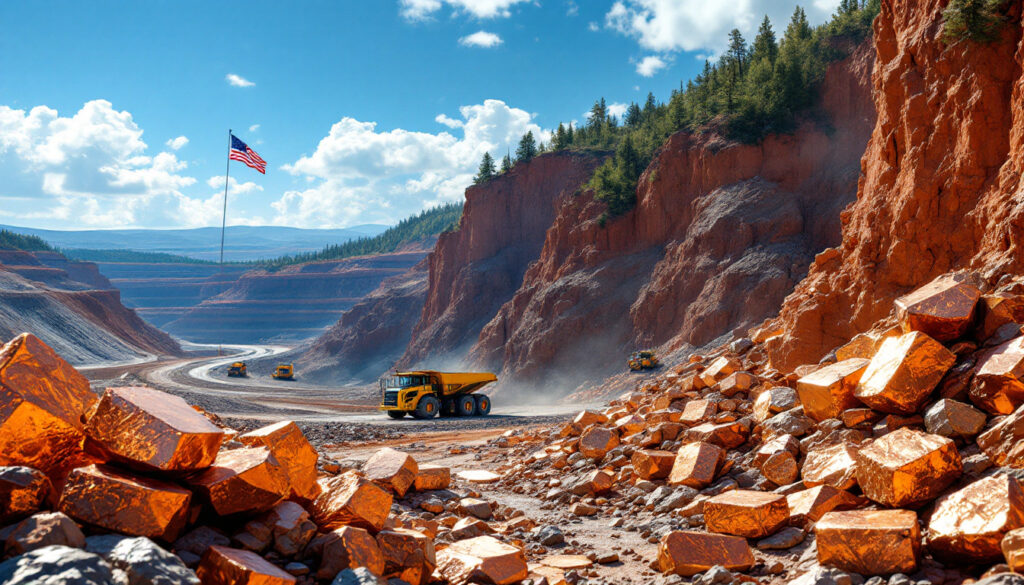The Strategic Importance of Critical Minerals in US Policy
What is Driving Trump's Focus on Critical Minerals?
The Trump administration's critical minerals strategy stems from three interconnected objectives: energy dominance, supply chain resilience, and geopolitical positioning. By prioritizing domestic production through executive actions, the administration seeks to reduce reliance on foreign suppliers, particularly China, which controls 40% of global refined copper production.
The March 2024 executive order explicitly linked copper to national security, noting its irreplaceable role in defense systems, grid infrastructure, and clean energy technologies. This policy shift reflects growing concerns over critical mineral shortages that could hinder American industrial competitiveness.
Trump's obsession with critical minerals represents a fundamental shift in American resource policy, moving from global market dependence to strategic self-sufficiency. This approach aims to revitalize declining US copper production, which has fallen from 1.92Mt in 1997 to just 1.1Mt today—a concerning 43% decrease despite growing demand.
Key Policy Initiatives Transforming the Mining Landscape
Four regulatory mechanisms have emerged as catalysts for industry transformation:
FAST-41 Designation: The inclusion of projects like Resolution Copper (Rio Tinto-BHP joint venture) in this expedited permitting program has reduced approval timelines from the historical 29-year average to under five years for prioritized developments.
Tariff Investigations: Ongoing probes into Chinese copper imports aim to level the playing field for domestic producers facing artificially depressed global prices.
Bureau of Land Management (BLM) Streamlining: The BLM's "Determination of Adequacy" process now enables preliminary project approvals within 14 days for compliant mine plans—a dramatic improvement from previous timeframes that often exceeded 12 months.
National Energy Dominance Council: This interagency body coordinates federal approvals, resolving jurisdictional conflicts that previously delayed projects like the Antler Copper Mine in Arizona.
The administration's comprehensive approach includes aggressive permitting reforms that slice through decades of regulatory complexity. As Nick Woolrych, CEO of New World Resources, noted: "The new regulatory framework has fundamentally changed the economics of copper development in the United States. What previously took decades can now be accomplished in years."
The Copper Supply Challenge Facing the United States
Why Copper is Critical to US Economic Security
Copper's conductivity, durability, and recyclability make it indispensable for:
Renewable Energy Systems: A single wind turbine contains 3-5 tonnes of copper, while solar farms require 5.5 tonnes per megawatt—far more than conventional power generation.
Electric Vehicles (EVs): EV manufacturing consumes 4x more copper than internal combustion vehicles (83 kg vs. 23 kg per unit), creating exponential demand growth as electrification accelerates.
Grid Modernization: The Department of Energy estimates $2.5 trillion in grid investments by 2035, necessitating 15 Mt of additional copper—more than the US has produced in the past decade combined.
Defense Applications: Advanced weapons systems, communications equipment, and naval vessels require significant copper quantities. A single Virginia-class submarine contains over 100 tonnes of copper, highlighting national security implications.
The administration's designation of copper as a critical mineral acknowledges these irreplaceable functions across multiple strategic sectors. Without increased domestic supply, the energy transition and defense modernization efforts face significant bottlenecks.
Current State of US Copper Production
The US copper industry faces structural challenges:
Production Decline: Output has fallen 43% since 1997 despite growing demand, creating a 1.4 Mt annual deficit that must be filled through imports from nations like Chile, Peru, and increasingly, China.
Aging Infrastructure: 70% of active US copper mines commenced operations before 1980, with declining ore grades averaging 0.4% versus 0.8% in Chile. This grade deterioration requires processing twice the ore tonnage for equivalent output.
Permitting Bottlenecks: Prior to 2024 reforms, the National Environmental Policy Act (NEPA) review process averaged 4.5 years for mining projects—compared to 1-2 years in competing jurisdictions like Australia.
The cumulative effect has been a hollowing of domestic capabilities precisely when copper demand is poised to surge. The International Energy Agency predicts global copper demand will double by 2040, primarily driven by clean energy technologies.
Major US Copper Projects Gaining Momentum
Resolution Copper: The Game-Changing Megaproject
This $6.9 billion project in Arizona exemplifies policy-driven revitalization:
Resource Scale: 1.7 billion tonnes grading 1.5% copper, capable of supplying 25% of US demand for 40 years. The deposit ranks among the top 10 undeveloped copper resources globally.
Economic Impact: Projected $1 billion annual contribution to GDP and 3,700 direct jobs, with a multiplier effect creating an additional 11,000 indirect positions throughout Arizona.
Regulatory Progress: FAST-41 status has accelerated environmental reviews, with final permits expected by Q3 2026—a dramatic improvement from the previous 2035 timeline.
Resolution's development history illustrates the transformative effect of Trump's commodity impact on regulatory certainty. After 20 years of delays and $2 billion in sunk costs, Rio Tinto and BHP had nearly abandoned the project. The March 2024 executive order and subsequent FAST-41 designation provided the regulatory certainty needed to revive development plans.
New World Resources' Antler Copper Project
Positioned as a near-term production solution, Antler's technical merits include:
High-Grade Resource: 14.2 Mt at 3.8% copper equivalent (543,000t contained metal), with byproduct credits from zinc (34,500t/yr) and precious metals (533,300oz silver and 6,000oz gold annually).
Cost Competitiveness: All-in sustaining costs (AISC) of $0.51/lb copper, leveraging high grades to offset US labor costs. This positions Antler in the lowest quartile of the global cost curve despite its US location.
Development Timeline: Permitting completion by February 2026 positions first production for 2027, coinciding with the current presidential term. This accelerated timeline reflects the efficiency gains from regulatory reforms.
New World's CEO Nick Woolrych emphasized the project's strategic significance: "Antler represents precisely the type of high-grade, near-term copper production that the administration's critical minerals policy aims to expedite. Our projected 30,100 copper equivalent tonnes of annual production directly supports American manufacturing and energy security goals."
The definitive feasibility study, expected by Q4 2024, will further define the project's economics in the context of the current copper price environment, which has remained above $4.70/lb for much of 2024.
Economic Impacts of Accelerated Permitting
How Permitting Timelines Are Being Transformed
The BLM's emergency approval protocol has altered project economics:
| Approval Stage | Historical Timeline | Post-2024 Timeline |
|---|---|---|
| Environmental Assessment | 12 months | 14 days |
| Mine Plan Approval | 24 months | 28 days |
| Federal Land Use Permits | 18 months | 45 days |
This 90% reduction in permitting duration reduces pre-production capital costs by an estimated $15-20/tonne of ore, dramatically improving project economics.
The systemic inefficiency of historical permitting processes cannot be overstated. According to a 2023 SNL Metals & Mining study, the average time from discovery to production for US copper deposits was 29 years—compared to 12 years in Australia and 7 years in Canada. This regulatory burden effectively rendered many otherwise economic deposits unviable.
The Bureau of Land Management's restructured "Determination of Adequacy" process now enables qualified projects on federal lands to receive preliminary approvals within 14 days, with full permitting completed in under 12 months. This transformation represents a paradigm shift in regulatory efficiency.
Financial Implications for Copper Developers
Streamlined approvals enhance project viability through:
Capital Efficiency: The Antler project's $298 million capex includes a 10.5% contingency, lower than the 15% industry average for US developments. This reduced contingency reflects lower regulatory risk.
Improved IRR: New World Resources forecasts a 34% post-tax IRR at $4.20/lb copper, rising to 41% at current $4.70/lb prices. This compares favorably to the 15-20% IRR typically required for project financing.
Risk Mitigation: Reduced holding costs (from $12M/yr to $4M/yr for mid-sized projects) improve financing terms. This allows explorers to advance projects to production with less dilutive capital raises.
For investors, these improvements translate directly to enhanced returns. Broker Argonaut Securities recently upgraded New World Resources with a price target representing significant upside potential, citing "dramatically improved permitting visibility" as a key catalyst.
Investment Opportunities in US Copper Sector
What Makes US Copper Projects Attractive?
Investors are capitalizing on three policy-driven advantages:
Price Support: Proposed 15% tariffs on imported copper concentrate could raise domestic prices by $0.50-0.70/lb, enhancing the economics of US projects regardless of global market conditions.
Geopolitical Premium: Defense Production Act allocations prioritize domestic copper for military applications, creating a captive market. This provides baseline demand security regardless of economic cycles.
Technological Synergy: DOE's $450 million Advanced Manufacturing Office grants support automation in mining operations, helping US producers offset higher labor costs through technological innovation.
Trump's critical minerals obsession has fundamentally altered the risk-reward calculus for US copper stocks. Projects previously considered marginal now offer compelling economics under the new regulatory and tariff framework.
For investors, the sector offers exposure to both copper's structural bull market and US policy tailwinds. As copper prices remain above $4.70/lb—driven by supply constraints and electrification demand—domestic producers stand to benefit disproportionately.
Emerging Developers to Watch
New World Resources (ASX:NWC): The Antler Copper Project represents one of the most advanced near-term production opportunities, with a definitive feasibility study scheduled for Q4 2024 and production targeted for 2027. The project's high grade (3.8% copper equivalent) positions it in the lowest quartile of the global cost curve.
Golden Mile Resources (ASX:G88): Maiden drilling at the Pearl Project targets 500,000t inferred resources by 2026, leveraging Arizona's established infrastructure. The company's drilling program commenced in June 2024, with initial results expected in Q3.
Dateline Resources (ASX:DTR): Recent BLM approvals at Colosseum highlight regulatory alignment, with gold-copper mineralization potential in California. The project benefits from its location on private land, further reducing permitting complexity.
These emerging players exemplify the new wave of US copper development catalyzed by critical minerals policy reform. Their technical merits—high grades, advantageous locations, and experienced management—position them to capitalize on the favorable regulatory environment.
Technical Analysis of Leading US Copper Projects
Resource Quality and Production Metrics
The Antler deposit's metallurgical advantages include:
Copper Recovery Rates: 92% through conventional flotation versus 85% industry average. This higher recovery translates directly to enhanced project economics.
Byproduct Contributions: Zinc and precious metals offset 22% of operating costs at current prices. This polymetallic nature provides natural hedging against copper price volatility.
Mine Life: 12-year initial operations with exploration potential to 25 years through underground extensions. Recent drilling has demonstrated mineralization remains open at depth and along strike.
The definitive feasibility study will further refine these metrics, but preliminary economic assessment indicates an NPV8 of US$524 million and an IRR of 34% at US$4.20/lb copper prices. At current prices above $4.70/lb, these economics improve substantially.
Annual production capacity stands at 16,400t copper, 34,500t zinc, 3,600t lead, 533,300oz silver, and 6,000oz gold—equating to 30,100 copper equivalent tonnes. This scale places Antler firmly in the mid-tier producer category upon commissioning.
Geological Advantages of US Deposits
Arizona's porphyry copper belt offers:
Depth Potential: Resolution Copper's resource extends to 2,100m depth, triple the average Chilean deposit. This vertical continuity enhances mining efficiency and reduces development costs per tonne.
Grade Consistency: Volcanogenic massive sulfide (VMS) deposits like Antler maintain +3% CuEq grades over 300m vertical intervals. This consistency reduces dilution and simplifies mine planning.
Infrastructure Synergies: 80% of proposed US copper projects are within 50km of existing processing facilities. This proximity reduces capital requirements for supporting infrastructure.
The geological characteristics of US copper deposits provide natural advantages that partially offset higher labor and regulatory costs. While grade is commonly cited as a disadvantage for US deposits compared to Chilean porphyries, this generalization masks significant variability. Understanding the ore deposits geology of high-grade VMS deposits like Antler demonstrates that selective US projects can compete globally on grade.
Challenges and Risks in US Copper Development
Persistent Obstacles
Despite regulatory progress, developers face:
Water Scarcity: Arizona's Tier 1 water shortage declaration requires $120/tonne desalination costs for new projects. The Colorado River Basin's chronic drought conditions place long-term constraints on water-intensive processing operations.
Labor Shortages: The Mining Industry Human Resources Council forecasts a 28% skilled worker deficit by 2030. This shortage is particularly acute in specialized roles like geotechnical engineers and metallurgists.
Capital Intensity: US underground mine development costs average $350/tonne vs. $220/tonne in Peru. This premium reflects higher labor costs, regulatory compliance expenses, and infrastructure requirements.
Environmental opposition remains significant despite regulatory streamlining. The Resolution Copper project, despite its FAST-41 designation, continues to face legal challenges from tribal groups and environmental organizations concerned about impacts to Oak Flat, a culturally significant area.
"Regulatory reform addresses permitting timelines, but water access remains the critical constraint for Arizona copper development. Securing sustainable water rights is now the primary development bottleneck." — Damon Dormer, Mining Analyst
Mitigation Strategies
Policy and industry responses include:
Advanced Recycling: The DOE's $75 million Copper Recycling Initiative aims to derive 30% of supply from scrap by 2030. This circular economy approach reduces water consumption by 85% compared to primary production.
Modular Plants: New World's phased development approach reduces initial capex by 40% through staged commissioning. This approach minimizes upfront capital requirements while demonstrating operational viability.
Community Benefit Agreements: Resolution Copper's $75 million commitment to Apache tribal communities sets precedent for stakeholder engagement. These agreements provide economic participation for affected communities, enhancing social license to operate.
Technological innovation offers partial solutions to persistent challenges. Water recycling systems can reduce consumption by 65-80%, while automation addresses skilled labor shortages. However, these solutions increase capital intensity, creating a complex optimization challenge for project developers.
The Global Context of US Copper Strategy
Impact on International Markets
US self-sufficiency efforts could reshape global trade:
Import Substitution: Reducing reliance on Chile (33% of US imports) and Peru (19%) may depress Atlantic Basin premiums. This regional price impact could benefit European consumers while complicating South American producers' economics.
Technological Competition: China's 60% control of copper refining capacity complicates decoupling efforts. The administration's focus on full supply chain development acknowledges this challenge, emphasizing both mining and refining capacity.
ESG Differentiation: US producers market "green copper" with 40% lower Scope 3 emissions than global averages. This ESG premium supports higher realized prices for domestic production.
Trump's critical minerals obsession represents a direct challenge to China's dominance in critical mineral supply chains. The geopolitical dimension of copper policy extends beyond economic considerations to fundamental national security concerns.
The administration's approach combines defensive measures (tariff investigations) with offensive capability building (permitting reform and financial incentives). This comprehensive strategy acknowledges that mineral security requires both protection from unfair competition and aggressive domestic capacity expansion.
Jurisdictional Comparison
| Metric | USA | Chile | DRC |
|---|---|---|---|
| Permitting Timeline | 3-5 yrs | 7-10 yrs | 1-2 yrs |
| Avg. Cash Costs | $2.20/lb | $1.50/lb | $1.80/lb |
| Political Risk Index | 15/100 | 35/100 | 85/100 |
| Water Consumption | 70m³/t | 96m³/t | 45 |
Want to Capitalise on the Next Major Mineral Discovery?
Discover why strategic mineral finds like copper can lead to exceptional returns by exploring Discovery Alert's dedicated discoveries page, where their proprietary Discovery IQ model transforms complex mineral data into actionable investment insights, giving you the edge you need in today's competitive market.




